Microstrip (Patch) Antennas
Back: Antennas List
Antenna Theory (Home)
On this page, we'll discuss the microstrip antenna, which is also commonly referred to as the patch antenna. [Note:
I'll use the terms microstrip antenna and patch antenna interchangeably.]
The rectangular patch antenna is analyzed, and what is learned here will be applied to understanding
PIFAs (Planar Inverted-F Antennas).
Introduction to Patch Antennas
Microstrip or patch antennas are becoming increasingly useful because they can be printed directly onto a circuit board. Microstrip antennas
are becoming very widespread within the mobile phone market. Patch antennas are low cost, have a low profile and are easily fabricated.
Consider the microstrip antenna shown in Figure 1, fed by a microstrip transmission line. The patch antenna, microstrip transmission line and
ground plane are made of high conductivity metal (typically copper). The patch is of length L,
width W, and sitting on top of a substrate (some dielectric circuit board) of thickness h with
permittivity
 .
The thickness of the ground plane or of the microstrip is not critically important.
Typically the height h is much smaller than the wavelength of operation, but not much smaller than 0.05 of a wavelength
or the antenna efficiency will be degraded.
.
The thickness of the ground plane or of the microstrip is not critically important.
Typically the height h is much smaller than the wavelength of operation, but not much smaller than 0.05 of a wavelength
or the antenna efficiency will be degraded.

(a) Top View of Patch Antenna

(b) Side View of Microstrip Antenna
Figure 1. Geometry of Microstrip (Patch) Antenna.
The frequency of operation of the patch antenna of Figure 1 is determined by the length L. The center frequency will
be approximately given by:

The above equation says that the microstrip antenna should have a length equal to one half of a wavelength within the dielectric (substrate)
medium.
The width W of the microstrip antenna controls the input impedance. Larger widths also can increase the bandwidth.
For a square patch antenna fed in the manner above,
the input impedance
will be on the order of 300 Ohms. By increasing the width, the impedance can be reduced. However, to decrease the input impedance
to 50 Ohms often requires a very wide patch antenna, which takes up a lot of valuable space.
The width further controls the
radiation pattern.
The normalized radiation pattern is
approximately given by:

In the above, k is the free-space
wavenumber, given by
 .
The magnitude of the fields, given by:
.
The magnitude of the fields, given by:

The fields of the microstrip antenna
are plotted in Figure 2 for W=L=0.5 .
.

Figure 2. Normalized Radiation Pattern for Microstrip (Patch) Antenna.
The directivity of patch antennas is approximately 5-7 dB. The fields are linearly polarized, and in the horizontal
direction when viewing the microstrip antenna as in Figure 1a (we'll see why in the next section).
Next we'll consider more aspects involved in Patch (Microstrip) antennas.
Fringing Fields for Microstrip Antennas
Consider a square patch antenna fed at the end as before in Figure 1a.
Assume the substrate is air (or styrofoam, with a permittivity equal to 1), and
that L=W=1.5 meters, so that the patch is to resonate at 100 MHz. The height h is taken to be 3 cm.
Note that microstrips are usually made for higher frequencies,
so that they are much smaller in practice.
When matched to a 200 Ohm load, the magnitude of
S11 is shown in Figure 3.

Figure 3. Magnitude of S11 versus Frequency for Square Patch Antenna.
Some noteworthy observations are apparent from Figure 3. First, the bandwidth of the patch antenna is very small. Rectangular
patch antennas are notoriously narrowband; the bandwidth of rectangular microstrip antennas are typically 3%.
Secondly, the microstrip antenna was designed
to operate at 100 MHz, but it is
resonant at approximately 96 MHz. This shift is due to
fringing fields around the antenna, which makes the patch seem longer. Hence, when designing a patch antenna it is typically trimmed
by 2-4% to achieve resonance at the desired frequency.
The fringing fields around the antenna can help explain why the microstrip antenna radiates. Consider the side view of
a patch antenna, shown in Figure 4. Note that since the current at the end of the patch is zero (open circuit end), the
current is maximum at the center of the half-wave patch and (theoretically) zero at the beginning of the patch. This low current value
at the feed explains in part why the impedance is high when fed at the end (we'll address this again later).
Since the patch antenna can be viewed as an open circuited transmission line, the voltage reflection coefficient
will be 1 (see the
transmission line tutorial for more information).
When this occurs, the voltage and current are out of phase. Hence, at the end of the patch the voltage
is at a maximum (say +V volts). At the start of the patch antenna (a half-wavelength away), the voltage must be at minimum (-V Volts).
Hence, the fields underneath the patch will resemble that of Figure 4, which roughly displays the fringing of the fields
around the edges.

Figure 4. Side view of patch antenna with E-fields shown underneath.
It is the fringing fields that are responsible for the radiation. Note that the fringing fields near the surface
of the patch antenna are both in the +y direction. Hence, the fringing E-fields on the edge of the microstrip antenna
add up in phase and produce the radiation of
the microstrip antenna. This paragraph is critical to understanding the patch antenna. The current adds up in
phase on the patch antenna as well; however, an equal current but with opposite direction is on the ground plane, which
cancels the radiation. This also explains why the microstrip antenna radiates but the microstrip transmission line
does not. The microstrip antenna's radiation arises from the fringing fields, which are due to the advantageous voltage
distribution; hence the radiation arises due to the voltage and not the current. The patch antenna is therefore a
"voltage radiator", as opposed to the
wire antennas,
which radiate because the currents add up in phase and are therefore "current radiators".
As a side note, the smaller
 is,
the more "bowed" the fringing fields
become; they extend farther away from the patch. Therefore, using a smaller permittivity for the substrate yields
better radiation. In contrast, when making a microstrip transmission line (where no power is to be radiated),
a high value of
is,
the more "bowed" the fringing fields
become; they extend farther away from the patch. Therefore, using a smaller permittivity for the substrate yields
better radiation. In contrast, when making a microstrip transmission line (where no power is to be radiated),
a high value of
 is desired, so that the fields are more tightly contained (less fringing),
resulting in less radiation. This is one of the trade-offs in patch antenna design. There have been research papers
written were distinct dielectrics (different permittivities) are used under the patch antenna and transmission line sections,
to circumvent this issue.
is desired, so that the fields are more tightly contained (less fringing),
resulting in less radiation. This is one of the trade-offs in patch antenna design. There have been research papers
written were distinct dielectrics (different permittivities) are used under the patch antenna and transmission line sections,
to circumvent this issue.
Next, we'll look at alternative methods of feeding the microstrip antenna (connecting the antenna to the receiver or transmitter).
Next: Feeding Methods for Patch Antennas
Top: Introduction to Microstrip Antennas
Antennas List
Antenna Theory Page
This page on microstrip antennas and patch antennas is copyrighted. No portion can be reproduced except by permission
from the author. Copyright 2011-2015, antenna-theory.com. Patch antennas, microstrip antennas.
Table of Contents for the Patch Antenna Pages:
1. Introduction, Parameters and Fields of Microstrip Antennas
2. Bandwidth and Fringing Fields
3. Feeding Methods for Patch Antennas
4. Tradeoffs and Design Parameters of Microstrip Antennas
5. Video Simulation of Transient Fields Under a Microstrip Antenna
6. Planar Inverted-F Antennas (PIFAs)
7. Video Introduction and Analysis of Patch/Microstrip Antennas
 .
The thickness of the ground plane or of the microstrip is not critically important.
Typically the height h is much smaller than the wavelength of operation, but not much smaller than 0.05 of a wavelength
or the antenna efficiency will be degraded.
.
The thickness of the ground plane or of the microstrip is not critically important.
Typically the height h is much smaller than the wavelength of operation, but not much smaller than 0.05 of a wavelength
or the antenna efficiency will be degraded.



 .
The magnitude of the fields, given by:
.
The magnitude of the fields, given by:
 .
.

